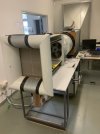The max airspeed is limited by the max tilt angle.
And it's the same for both drones.
Max Tilt Angle 30° (S Mode)
Post #19 is quite clear, but reading it again won't help make it correct, especially the part quoted above.
As previously stated I don't think it really could go much faster than 13m/s in S mode. This is is NOT due to limited max tilt as the drone doesn't even use the full 30deg tilt to achieve 13m/s. Further evidence that tilt isn't limiting the speed is given by increasing the max tilt to higher than 30 (I've experimented with 40deg) - no increase in top speed is observed.
You've acknowledged that DJI has included a firmware speed limiter to stop you exceeding the mode's max groundspeed by using a tailwind. If you fly in still air and give full fwd stick the drone will reach 13m/s in S mode. This is the speed at which the speed limiter would prevent any further increase in speed, whether the aircraft was capable of going any faster or not (I don't believe the
Mini 1 can, but not for the reason you've presented)
I believe maximum air speed of the Mini1 is limited due to max thrust. A certain amount of thrust is required to stay airborne, and any available thrust beyond that can be used to push the aircraft forward. As the drone tilts further to give a larger horizontal component to its thrust vector the body of the aircraft starts to provide downthrust - essentially its relatively flat upper and lower surfaces act like a crude airfoil. The higher the forward speed the greater this thrust becomes, so the more of the total thrust is required just to maintain altitude, and the less spare is available to push the aircraft forward. This would mean that the aircraft couldn't use its full tilt to achieve its max airspeed, and this agrees well with my observation that at 13m/s in still air the
Mini 1 doesn't use 30deg of tilt.
Now, if you rebuilt the Mini1 with more powerful motors and a slightly better battery to feed these motors, it would have a little bit more thrust, and could potentially achieve higher airspeeds. But If the 13m/s speed limiter was still in place then you'd never exceed a ground speed of 13m/s but could potentially exceed an airspeed of 13m/s. This would manifest itself as better wind resistance and tallies with the observations presented in post #17.











